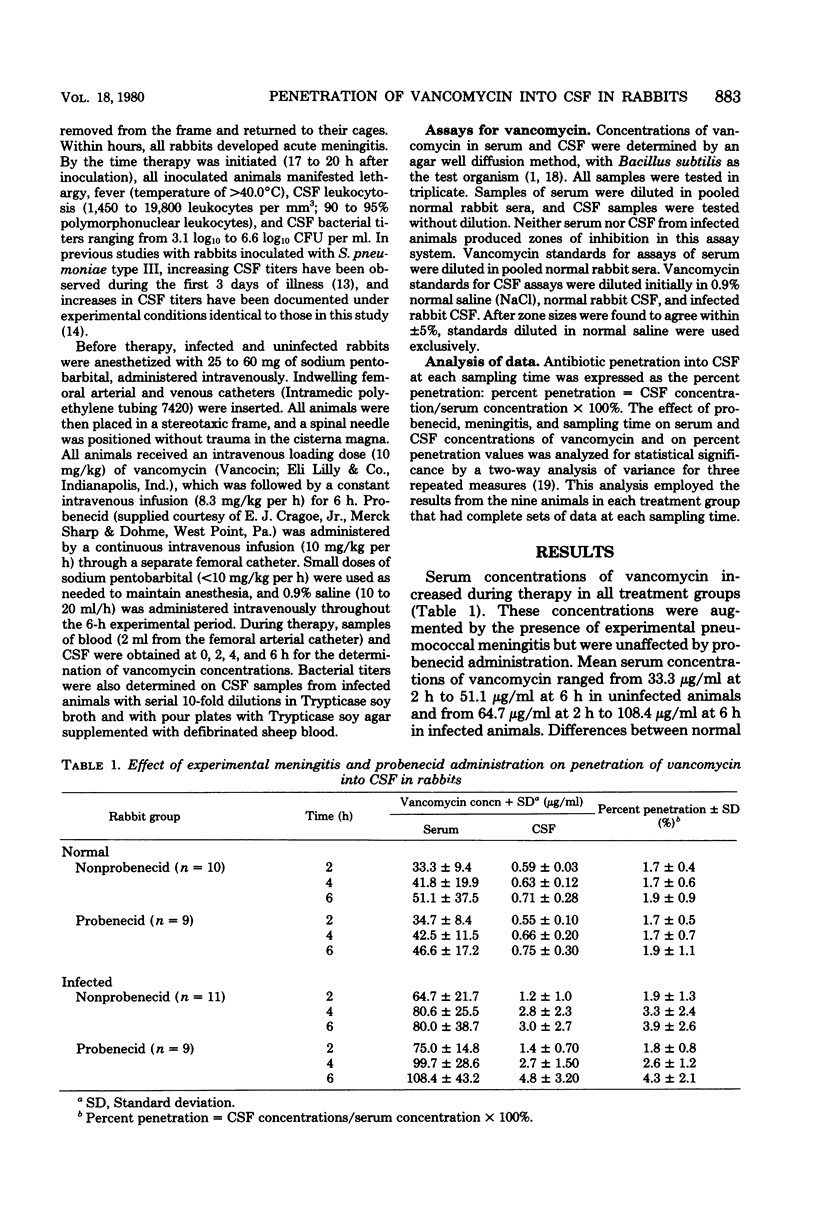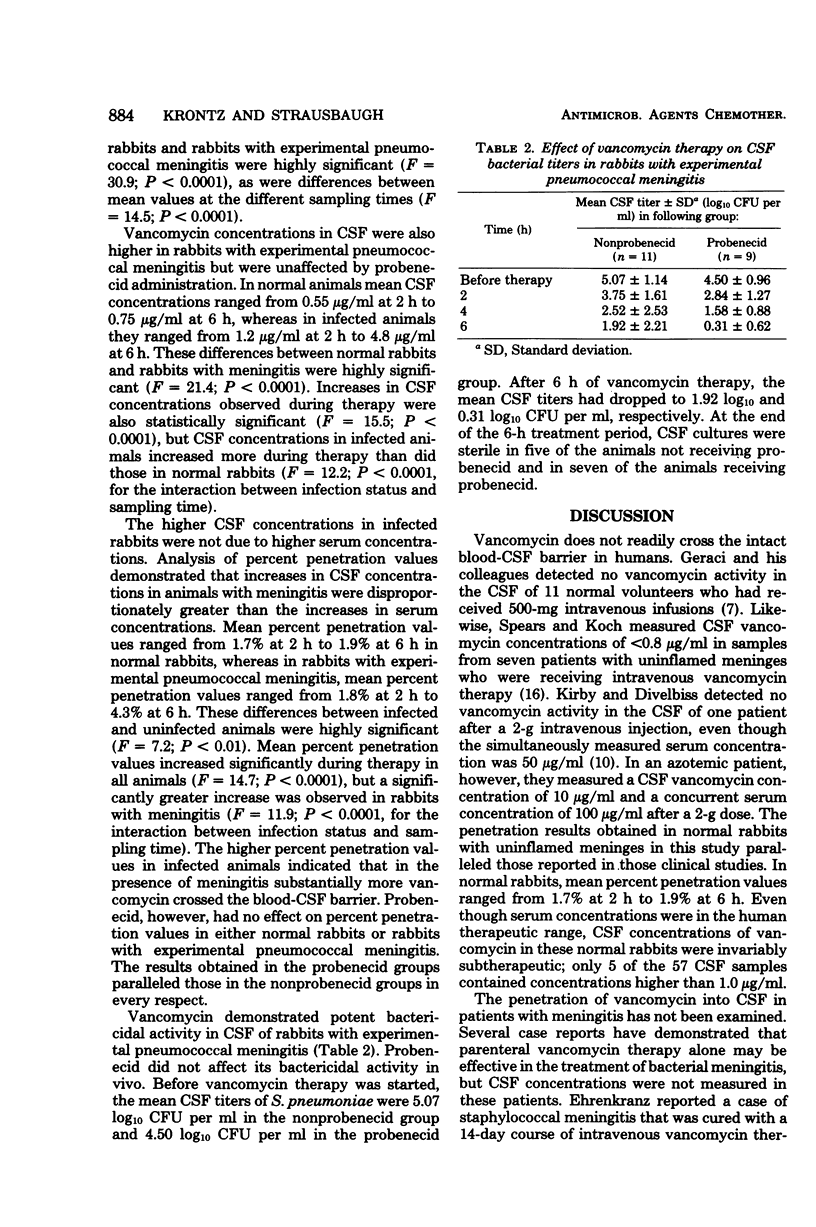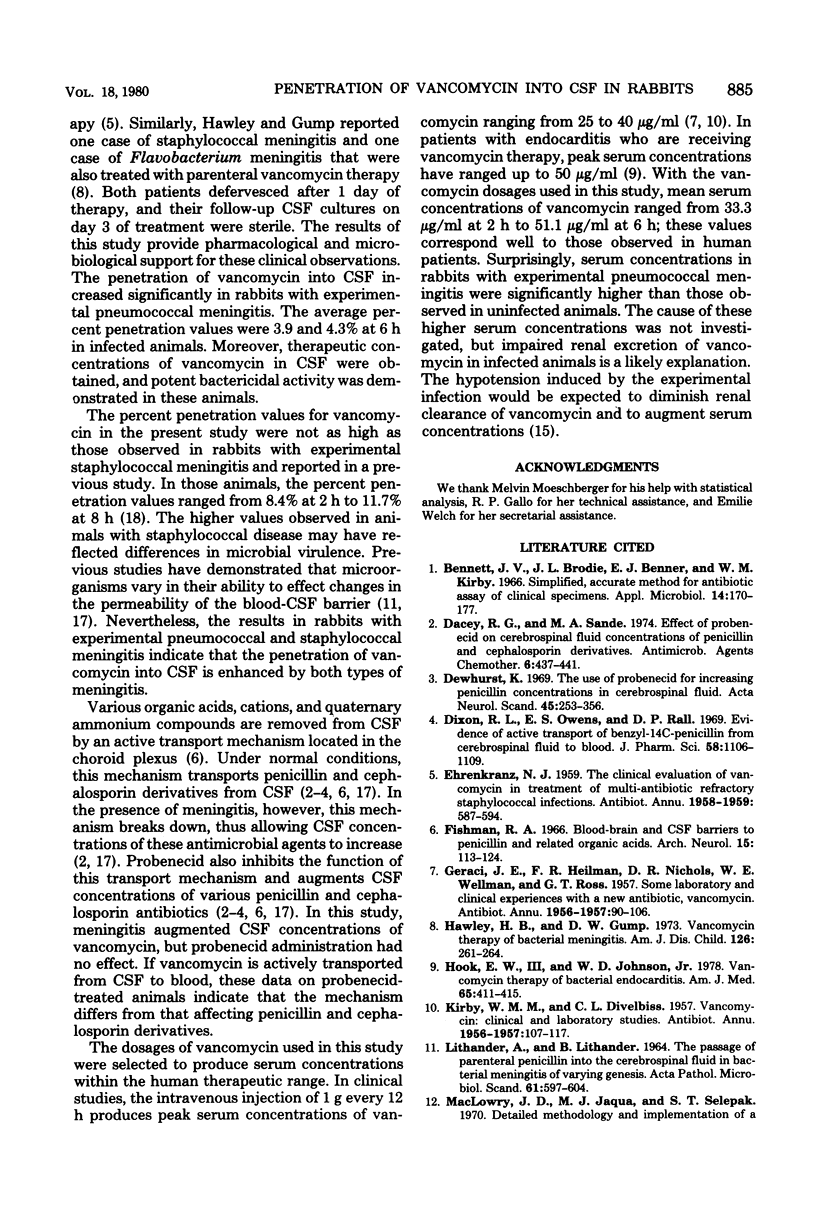Abstract
This study examined the effects of experimental pneumococcal meningitis and probenecid administration on the penetration of parenterally administered vancomycin into cerebrospinal fluid in rabbits. Bacterial killing was also examined in infected animals. Meningitis was induced by intracisternal inoculation of Streptococcus pneumoniae. Vancomycin was administered in a loading dose followed by a continuous intravenous infusion for 6 h. Serum and cerebrospinal fluid samples were obtained at 0, 2, 4, and 6 h for antibiotic assays and quantitative cultures. Meningitis significantly enhanced the penetration of vancomycin into cerebrospinal fluid, but probenecid administration had no effect. In normal rabbits, at 6 h the mean percent penetration (cerebrospinal fluid concentration/serum concentration x 100%) +/- the standard deviation was 1.9 +/- 0.9% in the nonprobenecid group (n = 10) and 1.9 +/- 1.1% in the probenecid group (n = 9). In rabbits with experimental pneumococcal meningitis, the mean percent penetration at 6 h was 3.9 +/- 2.6% in the nonprobenecid group (n = 11) and 4.3 +/- 2.1% in the probenecid group (n = 9). Mean bacterial titers in the cerebrospinal fluid of infected animals decreased by more than 3.0 log 10 colony-forming units per ml in both the nonprobenecid and the probenecid groups.
Full text
PDF




Selected References
These references are in PubMed. This may not be the complete list of references from this article.
- Bennett J. V., Brodie J. L., Benner E. J., Kirby W. M. Simplified, accurate method for antibiotic assay of clinical specimens. Appl Microbiol. 1966 Mar;14(2):170–177. doi: 10.1128/am.14.2.170-177.1966. [DOI] [PMC free article] [PubMed] [Google Scholar]
- Dacey R. G., Sande M. A. Effect of probenecid on cerebrospinal fluid concentrations of penicillin and cephalosporin derivatives. Antimicrob Agents Chemother. 1974 Oct;6(4):437–441. doi: 10.1128/aac.6.4.437. [DOI] [PMC free article] [PubMed] [Google Scholar]
- Dixon R. L., Owens E. S., Rall D. P. Evidence of active transport of benzyl-14C-penicillin from cerebrospinal fluid to blood. J Pharm Sci. 1969 Sep;58(9):1106–1109. doi: 10.1002/jps.2600580914. [DOI] [PubMed] [Google Scholar]
- EHRENKRANZ N. J. The clinical evaluation of vancomycin in treatment of multi-antibiotic refractory staphylococcal infections. Antibiot Annu. 1958;6:587–594. [PubMed] [Google Scholar]
- Fishman R. A. Blood-brain and CSF barriers to penicillin and related organic acids. Arch Neurol. 1966 Aug;15(2):113–124. doi: 10.1001/archneur.1966.00470140003001. [DOI] [PubMed] [Google Scholar]
- GERACI J. E., HEILMAN F. R., NICHOLS D. R., WELLMAN E. W., ROSS G. T. Some laboratory and clinical experiences with a new antibiotic, vancomycin. Antibiot Annu. 1956:90–106. [PubMed] [Google Scholar]
- Hawley H. B., Gump D. W. Vancomycin therapy of bacterial meningitis. Am J Dis Child. 1973 Aug;126(2):261–264. doi: 10.1001/archpedi.1973.02110190231025. [DOI] [PubMed] [Google Scholar]
- Hook E. W., 3rd, Johnson W. D., Jr Vancomycin therapy of bacterial endocarditis. Am J Med. 1978 Sep;65(3):411–415. doi: 10.1016/0002-9343(78)90766-0. [DOI] [PubMed] [Google Scholar]
- KIRBY W. M., DIVELBISS C. L. Vancomycin; clinical and laboratory studies. Antibiot Annu. 1956:107–117. [PubMed] [Google Scholar]
- LITHANDER A., LITHANDER B. THE PASSAGE OF PARENTERAL PENICILLIN INTO THE CEREBROSPINAL FLUID IN BACTERIAL MENINGITIS OF VARYING GENESIS: AN EXPERIMENTAL INVESTIGATION ON RABBITS. Acta Pathol Microbiol Scand. 1964;61:597–604. doi: 10.1111/apm.1964.61.4.597. [DOI] [PubMed] [Google Scholar]
- MacLowry J. D., Jaqua M. J., Selepak S. T. Detailed methodology and implementation of a semiautomated serial dilution microtechnique for antimicrobial susceptibility testing. Appl Microbiol. 1970 Jul;20(1):46–53. doi: 10.1128/am.20.1.46-53.1970. [DOI] [PMC free article] [PubMed] [Google Scholar]
- O'Donoghue J. M., Schweid A. I., Beaty H. N. Experimental pneumococcal meningitis I: a rabbit model. Proc Soc Exp Biol Med. 1974 Jun;146(2):571–574. doi: 10.3181/00379727-146-38149. [DOI] [PubMed] [Google Scholar]
- SPEARS R. L., KOCH R. The use of vancomycin in pediatrics. Antibiot Annu. 1959;7:798–803. [PubMed] [Google Scholar]
- Sande M. A., Sherertz R. J., Zak O., Strausbaugh L. J. Cephalosporin antibiotics in therapy of experimental Streptococcus pneumoniae and Haemophilus influenzae meningitis in rabbits. J Infect Dis. 1978 May;137 (Suppl):S161–S168. doi: 10.1093/infdis/137.supplement.s161. [DOI] [PubMed] [Google Scholar]
- Sears M. R., O'Donoghue J. M., Fisher H. K., Beaty H. N. Effect of experimental pneumococcal meningitis on respiration and circulation in the rabbit. J Clin Invest. 1974 Jul;54(1):18–23. doi: 10.1172/JCI107740. [DOI] [PMC free article] [PubMed] [Google Scholar]
- Spector R., Lorenzo A. V. Inhibition of penicillin transport from the cerebrospinal fluid after intracisternal inoculation of bacteria. J Clin Invest. 1974 Aug;54(2):316–325. doi: 10.1172/JCI107767. [DOI] [PMC free article] [PubMed] [Google Scholar]
- Strausbaugh L. J., Murray T. W., Sande M. A. Comparative penetration of six antibiotics into the cerebrospinal fluid of rabbits with experimental staphylococcal meningitis. J Antimicrob Chemother. 1980 May;6(3):363–371. doi: 10.1093/jac/6.3.363. [DOI] [PubMed] [Google Scholar]


